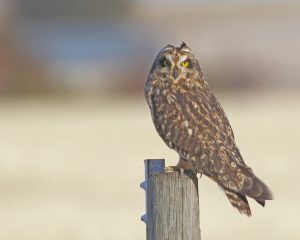Short-eared Owl
The short-eared owl, colloquially the small or little eared owl, has earned its name due to its tuffet of feathers resembling two short ears. The dimorphic species has a round and large head. It is different than the long-eared owl which has long ear-like feathers.
Scientific Classification
| Kingdom | Animalia |
| Phylum | Chordata |
| Class | Aves |
| Order | Strigiformes |
| Family | Strigidae |
| Genus | Asio |
| Scientific Name | Asio flammeus |
Quick Information
| Other Names | Hibou des marais (in French), Búho Campestre (in Spanish) |
| Description | Size: 13-16.9 in (33.02-42.9 cm) Wingspan: 33-43 in (85-110 cm) Weight: 7-17 oz (198.4-481.9 g) Color: Pale face with yellow eyes and black outlines, the belly, chest, and upperwings are pale, so are the underwings but they exhibit a comma-like mark around the wrist and a brown streaked breast |
| Distribution | Asia, Europe, South and North America, the Galapagos Islands, Hawaii, the Caribbean |
| Habitat | Savanna, meadow, tundra, prairie and places with low vegetation |
| Subspecies | 1. A. f. bogotensis 2. A. f. domingensis 3. A. f. flammeus 4. A. f. galapagoensis 5. A. f. pallidicaudus 6. A. f. ponapensis 7. A. f. portoricensis 8. A. f. sandwichensis 9. A. f. sanfordi 10. A. f. suinda 11. A. f. cubensis |
| Sounds & Communication | Continuous “toot-toot”, “waowk, waowk, a loud eeee-yerp sound especially during the breeding time, and a rough barking type call |
| Lifespan | 10-15 years |
| Diet | Voles, mice, rabbits, muskrats, gophers, shrews, smaller birds, grasshoppers, roaches, caterpillars and katydids |
| Adaptations | 1. Their plumage is silky and doesn’t produce any sound while in flight, helping them hunt stealthily 2. They can adjust to various temperatures and locations 3. Their buoyant body enables them to have a moth-like look 4. Their diet is the reason why their eyesight is so strong |
| Predators | Snowy owls, falcons, and raptors |
| IUCN Conservation Status | Least Concern |
Behavior
- Short-eared owls make colonies in order to live together, unlike other owl species
- They are mostly active and seen during the day, quite contrary to other owls
- They chase their preys before killing them off and carrying them afterward in their talons
Mating and Reproduction
Male owls perform a sky dancing session to allure females through wing clapping and singing. In the northern hemisphere, the breeding season is from March to June. Although mainly monogamous, they might be polygamous at times. After the mating, a female owl lays around 1-11 white eggs sizing 1.5-17 inches in her nest that is 10 inches wide and 2 inches long. The eggs are incubated for 21-37 days.
Life-cycle
Hatchlings fledge after 4 weeks and start hunting after 1-2 weeks on their own. They become sexually mature around 1 year of age.
Interesting Facts
- The owls sometimes harass eagles and falcons just for the sake of fun
- They have a liking to travel overseas by sitting on a ship
- Female owls sometimes cover their eggs with their poop to protect the eggs from predators
References
- http://www.oiseaux-birds.com/card-short-eared-owl.html
- https://www.audubon.org/field-guide/bird/short-eared-owl
- https://www.allaboutbirds.org/guide/Short-eared_Owl/overview
- https://www.nps.gov/articles/short-eared-owl.htm
Published on April 19th 2019 by Sahana Kanjilal under Coniferous Forest Animals.
Article was last reviewed on 17th July 2023.











